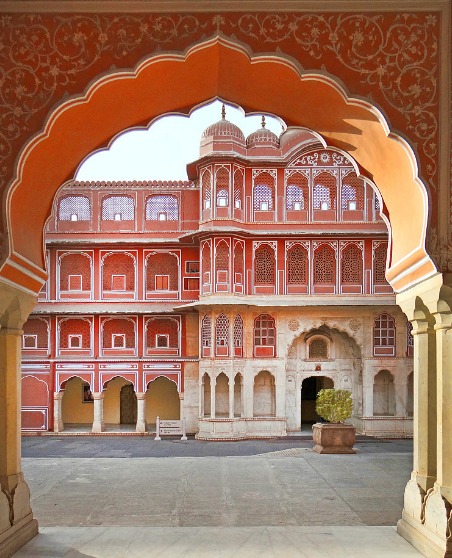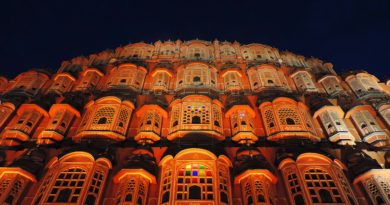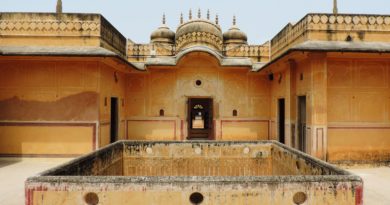City Palace of Jaipur- Royalty & Class At Its Best
There is so much to discover in Jaipur right from magnificent heritage destinations to breathtakingly erected forts and their marvellous architecture. And one among them with a placard reading “strictly not to be missed” is none other than City Palace in Jaipur, Rajasthan. The prime attraction for tourists, the rich legacy of the historic palace takes you to the glorious past of the Maharajas and their lifestyle. The City Palace of Jaipur witnessed its establishment during 1727.
During the same duration Pink City aka Jaipur – one of the first planned cities of medieval India – was announced as the official court of the Maharaja Sawai Jai Singh II. The court was shifted from Amber due to water issues and population surge. He appointed Vidhyadhar Bhattacharya – a well-known Bengali Architect of its era – to design this palace. He conceived it as per the rules of Vaastu Shastra.
Since the year 1727 to 1949, the City Palace remained as the administrative seat of the Maharaja of Jaipur. The City Palace of Jaipur symbolises an ideal and exquisite amalgamation of Mughal and Rajput architecture.
About City Palace

The palace is currently the home of Jaipur royal family decedents. The family of the last ruling Maharaja resides in one of the elite portions of the palace, which is a private space and cannot be visited by the public. The City Palace also has the museum of Maharaja Sawai Man Singh II. The palace complex is enormous and has many buildings that include different galleries, restaurants, offices and courtyards run by the Museum Trust.
The Trust takes care of the Maharaja Sawai Man Singh II Museum and its royal cenotaphs aka chhatris. The building complex comprises of various courtyards and structures with architectural marvel including Sarvatobhadra Chowk, Sabha Niwas, Pritam Chowk, Mubarak Mahal, Chandra Mahal, and others.
Some Must See at the City Palace
Mubarak Mahal
The fascinating building is the reception area for the tourists. The Mahal now functions as a museum. It displays a vast collection of traditional Rajasthani outfits and textiles worn by the kings and queens of the Rajputana state.
Chandra Mahal
The enormous 7-storey building of Chandra Mahal consists of various sections within called as Shri Niwas, Mukut Mahal, Ranga Mandir, Sukh Niwas, and a museum. Each section witnesses sophisticated beauty in its sense. It features unique mirror work, select paintings, several and distinctively designed flower vases. The traditional textile treasure of the royal maharajas includes their costumes, embroidered shawls, ornamental clothes, Kashmiri pashminas, silk saris, and Sanganeri block prints.
Painted with the royal blue shade ‘Sukh Nivas’ is decorated with unique white lining. Moreover, the ‘Rang Mandir’ is beautified by small size mirror embedded walls, ceiling and pillars providing a stunning attraction to the visitors. Embroidered with classic yet lovely looking mica and gold leaf, it’s all over adorned with mirror walls and blue tiles.
Maharani Palace
The royal palace, a dedicated residence for the queens, it is this royal palace is adorned with gems and semi-precious stones. The armoury in Maharani’s Palace reveals the weapon collections and ceremonial items. The intricate ceiling of this mahal is comprising of beautiful precious stones.
Besides the attractions, a visit to Diwan-i-Khas (Hall of Private Audience), Baggi Khana, and Diwan-i-Am (Hall of Public Audience) are a must. Bounded by four gates is this Pritam Niwas Chowk is an inner courtyard decked with beautiful motifs.
Inside Maharaja Sawai Man Singh II Museum
Maharaja Sawai Man Singh II Museum is a spectator’s delight and can be found in the Mubarak Mahal. It displays an exclusive assortment of renowned royal costumes, Benarasi silk sarees, Pashmina (Kashmiri) shawls, and other clothing with local Sanganeri prints and folk embroidery.
The gallery sections inside the museum include Sarvatobhadra, Sabha Niwas, Textile gallery, Sileh Khana, Painting and Photography gallery.
Sarvatobhadra: It is an open pavilion that has two silver urns. Other interesting things on display are the spears, shields, arrows, and other warfare items.
Sabha Niwas: A large room that kept the ceremonial assemblies of the then Maharaja of Jaipur. Here the magnificent artwork, furniture, medals, and garments are the centre of attraction.
Textile Gallery: It showcases a wide array of Indian fabrics and textiles some even as old as three centuries.
Sileh Khana: The vast collection of arms and armour used in the battles is exhibited here. This comprises of axes, guns, spears, daggers, etc.
Painting and Photography Gallery: Added in the museum in the recent past, it displays paintings and photographs from the 18th – 20th century. The fine artwork and paintings include Hindu mythological illustrated manuscript series of the Durga Saptashati and Bhagwat Puraan, the Ragamala, Krishna Leela, and others. All the photographs on display are from the collection of Maharaja Sawai Ram Singh II – the Jaipur king from 1835 to 1880 – also known as the first photographer king.
Within the museum premises, one can also shop from Palace Atelier. Moreover, for great tasting food, the restaurant called Baradari and the snacks bar can be visited at Amba Pol.
Unique Architecture of City Palace
The stunning and grandeur structure of the Jaipur City Palace is designed in grid manner. The palace has three gates viz. Virendra Pol’ Udai Pol’ and ‘Tripolia Gate’, at convenient corners to ensure easy entry and exit for the visitors. Wherein for visitors and touring people, two gates, Virendra Pol and the Udai Pol are dedicated, while Tripolia Gate is used by the royal family.
The palace premises features temples, palaces, gardens, and balconies with marbles, inlaid ornamentations, jali work, etc. The structural design reflects the essence of authentic Mughal architecture. Distinct blend of colours, art and design can be witnessed all over the palace, which makes it one of the most vibrant palaces in the country.
What are the timings of City Palace of Jaipur?
The palace opens in the morning at 09.30 am and closes down by 05.00 pm in the evening. It takes around two to three hours to explore the entire palace.
What are the City Palace Jaipur ticket rates?
Tickets are separate for palace sighting and museum visit. The Jaipur City Palace entry fees starts from INR 130 for Indian visitors and goes up to INR 500 for the foreign residents. Given below is the detailed entry fee list.
| Category | Fee/Ticket Amount |
| Indian Nationals | INR 130 |
| Children (Indian) | INR 70 |
| Senior Citizen (Indian) | INR 110 |
| Foreign Nationals | INR 500 |
| Photography | INR 50 |
| Videography | INR 150 |
| Audio Guides | INR 200 |
For quality experience and better learning of the palace and museum history, a guide or an audio guide can prove very helpful, and is highly suggested to get benefitted from it.
When is the best time to time visit the Jaipur City Palace?
Climatic conditions that are neither too cool nor too hot are ideal for any sightseeing. Same goes with the palace and museum exploration. Being the capital city of Rajasthan, Jaipur mostly hot and dry round the year, some respite from the heat is only witnessed during day times of winter season.
Therefore, the perfect time to visit City Palace of Jaipur is during October and March when it is relatively cooler than other months.
How to reach City Palace Jaipur?
The transportation service in Jaipur city is quite commendable. There are plenty of vehicular options available that can take you to the City Palace. You can reach the palace by bus, cab/taxi or auto-rickshaw. The distance between the Jaipur International Airport and palace is of 12.8 km, while from the Jaipur Railway Station it is merely around 4 km.
So, as a travel and admirer of historical monuments, there is so much to discover here. And if you are touring Northern India or Rajasthan, missing City Palace of Jaipur is a strictly no, no. Moreover, if you plan to stay in Jaipur for the sightseeing, we can help you get a premium hotel in your budget nearby the monument, and even during your hotel stay you can always catch a glimpse of your favourite palace.




